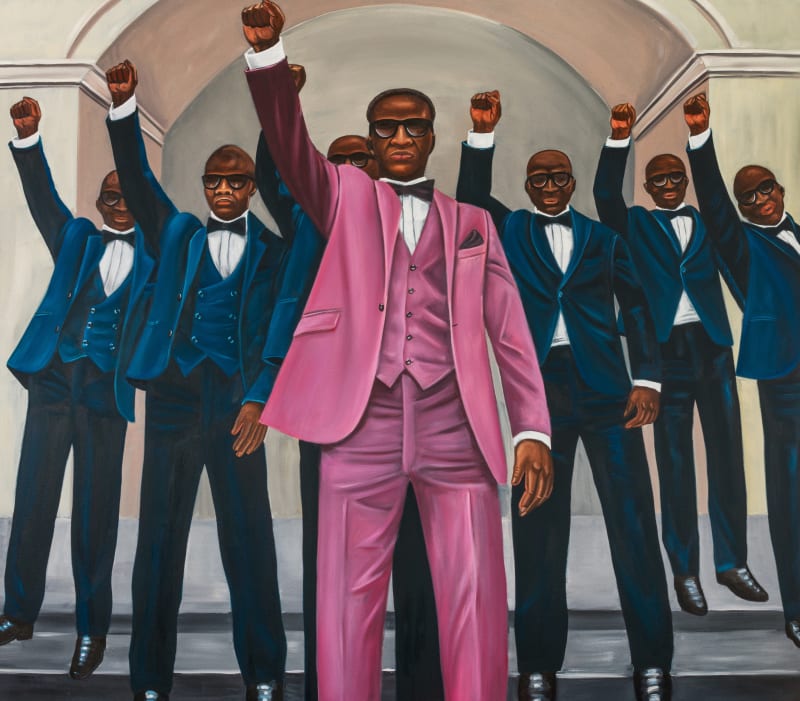Private View: Thursday, 23rd of November 2023, 6.30 - 8:30pm
Men in sharply tailored suits gather against brightly coloured backgrounds – holding a pint, sitting in a leather arm chair, embracing one another, their fists raised into the air. This latest series of paintings by the Congolese artist Zemba Luzamba is inspired by the concept of brotherhood and the communal practices, specifically those that take place around weddings. Bringing together all new work, Folk Ritual, the artist’s solo exhibition at Kristin Hjellegjerde Gallery, Berlin examines the ways in which we make sense of and transition through different stages of life.
As with all of Luzamba’s work, the contextual background detail is stripped away and replaced with bold colour fields that focus the viewer’s attention on body language, clothing and facial expressions, while also creating space for interpretation. In this latest series, the occasion is hinted at through the groom’s white suit in Boys will be Boys II and the bride’s wedding dress in the painting Two Black Roses, but the scenes could otherwise depict a variety of ceremonial events – a birthday, christening, graduation or even a protest.
Take, for instance, the painting Amandla in which a group of men stand in an arrow-shaped formation under an arch with their fists raised into the air. Amandla in the South African languages of Xhosa and Zulu means ‘power’ and was used as a rallying cry in resistance against apartheid while the raised fist is a universally recognised symbol of strength and solidarity. These days, however, both gestures are also used as a more informal expression of encouragement. ‘At weddings for example people might shout Amandla as a way of supporting the couple and showing them they are not alone,’ explains Luzamba.
The suits that Luzamba’s characters wear similarly take on a double meaning. They are a uniform that again expresses solidarity and community, in this case, with the groom and are befitting of the formality and celebratory nature of the event. At the same time, they make reference a Congolese subculture known as SAPE (the Société des Ambianceurs et des Personnes Élégantes) that emerged in the 1960s and 70s when President Mobutu banned the wearing of Western-style style suits in favour of the abacost, a lightweight suit which was traditionally worn without a tie. The abacost was seen as the uniform of Mobutu’s supporters, especially those who had benefited from his regime. As such, the wearing of a suit and tie became a symbol of resistance and freedom. ‘It still has that association for me and for many Congolese,’ says Luzamba.
That sense of pride is perhaps most clearly expressed in the painting Boys will be Boys, which depicts the groom’s party wearing matching suits with pink ties and handkerchiefs, their heads turned towards the viewer with sombre expressions. As with all of the works in the series, Luzamba shies away from the stereotypical overblown wedding portraits of love and happiness to instead capture complex moments of apprehension, anxiety and even grief. Two Black Roses, for example, depicts the bride in-between two men – it is unclear which is the groom – each of whom is holding a black rose, traditionally a symbol not of celebration, but of death and mourning. ‘The roses represent the loss of the past and the uncertainty of the future. It is an acknowledgement that not everything is going to be easy or beautiful,’ Luzamba says. At the same time, the bride is not alone: her arms reach out to touch both men, creating a powerful pose of togetherness.
In a sense this is what Folk Ritual is all about: the communal beliefs and practices – whether it be the simple ritual of drinking a pint with friends or raising a fist in the air – that provide us with the strength to overcome uncertainty.


